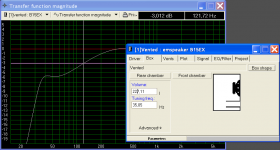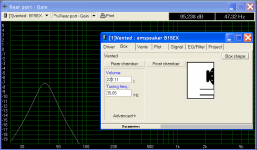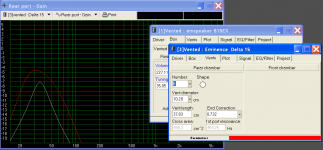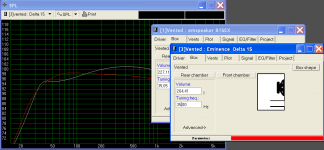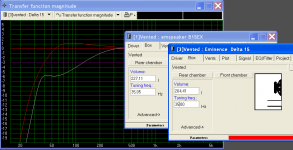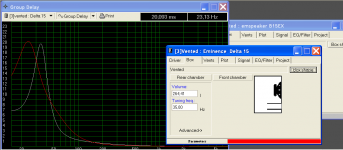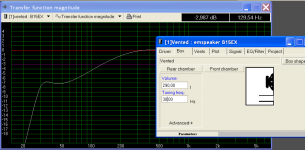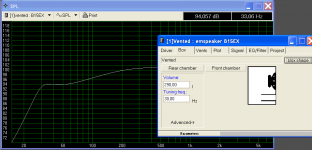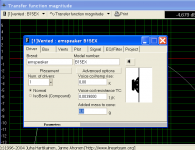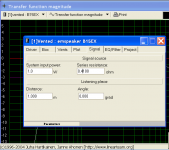For example the beginner think a average 100dB loud speaker does 100dB down to cut off. First mistake. http://www.emspeaker.com/boutique/topic3/page4.html
You can see at the qts and Fs if there is some bass to aspect or not.
For example the very exspensive EMspeaker B15EX. Cost 1400 euro or 2000$.
100dB average let simulate it in a onken like enclosure. What do we see -3dB at 120Hz (97dB 1Wmtr).
35Hz 94dB 1Wmtr. So you can use it down to 35Hz then you have to attenuate above 100Hz -6dB so average spl level is 94dB 1Wmtr with the extreme expensive woofer.

And if this onken enclosure is 1.2 mtr from the back-wall like on the picture, the 60Hz area will also drop -3dB so that will do 91dB 1Wmtr. Overall poor bass performance.
You can see at the qts and Fs if there is some bass to aspect or not.
For example the very exspensive EMspeaker B15EX. Cost 1400 euro or 2000$.
100dB average let simulate it in a onken like enclosure. What do we see -3dB at 120Hz (97dB 1Wmtr).
35Hz 94dB 1Wmtr. So you can use it down to 35Hz then you have to attenuate above 100Hz -6dB so average spl level is 94dB 1Wmtr with the extreme expensive woofer.

And if this onken enclosure is 1.2 mtr from the back-wall like on the picture, the 60Hz area will also drop -3dB so that will do 91dB 1Wmtr. Overall poor bass performance.
Attachments
Last edited:
Lets compare the 2000$ EMspeaker to the 130$ eminence delta 15".
The eminence has -3dB at 44Hz 95,5 dB. With port gain it will do 40Hz and it extends easy down to 30Hz.
When I had a EMspeaker in my onken I would spend 90 euro and try a eminence delta to see if helmuth is right.
Succes
In pictures
grey line EMspeaker
and
red line Eminence Delta 15"
The eminence has -3dB at 44Hz 95,5 dB. With port gain it will do 40Hz and it extends easy down to 30Hz.
When I had a EMspeaker in my onken I would spend 90 euro and try a eminence delta to see if helmuth is right.
Succes
In pictures
grey line EMspeaker
and
red line Eminence Delta 15"
Attachments
Last edited:
On groupdelay the eminence outperforms the EMspeaker also much better acceleration.
It is nice when frequency X Groupdelay is smaller then 400 as a rule of the thumb.
But still why build a onken when a openbaffle performs better box-less sound.
It is nice when frequency X Groupdelay is smaller then 400 as a rule of the thumb.
But still why build a onken when a openbaffle performs better box-less sound.
Attachments
The HELMUTH CRAP
Hello HELMUTH,
You know anything about anything. You use software and you just to transcribe the results. This isn’t correct.
Firstly, effectively there is a mistake. You dare awkwardly use a speaker with a QTS= 0,146 for calculate a bass reflex cabinet. Any audiophile know that the optimum QTS for a bass reflex enclosure is 0,25
You have a big mistake!😕
You don’t know either that the QTS and VAS of a speaker with a magnetic field, B15EX Emspeaker, range with the voltage of the field coil!!!
And you just realize that by reading what I just wrote you posted huge crap!!!
And yes, M. HELMUTH, you don’t have the good parameters of this speaker!!!😉
And secondly the volume of the ONKEN enclosure is arround 290l and no 224l !!😉
I am repeat, today , it’s easy to calculate a cabinet with a software !! But it’s more difficult to have a very good result, mainly you know anathing.
HELMUTH, return to the school before post anything to me.
Cdt.
EBA
Hello HELMUTH,
You know anything about anything. You use software and you just to transcribe the results. This isn’t correct.
Firstly, effectively there is a mistake. You dare awkwardly use a speaker with a QTS= 0,146 for calculate a bass reflex cabinet. Any audiophile know that the optimum QTS for a bass reflex enclosure is 0,25
You have a big mistake!😕
You don’t know either that the QTS and VAS of a speaker with a magnetic field, B15EX Emspeaker, range with the voltage of the field coil!!!
And you just realize that by reading what I just wrote you posted huge crap!!!
And yes, M. HELMUTH, you don’t have the good parameters of this speaker!!!😉
And secondly the volume of the ONKEN enclosure is arround 290l and no 224l !!😉
I am repeat, today , it’s easy to calculate a cabinet with a software !! But it’s more difficult to have a very good result, mainly you know anathing.
HELMUTH, return to the school before post anything to me.
Cdt.
EBA
Hi EBA,
Just show the simulation and the measurement of your onken EBA. Because like I stated I do not think you can make 98dB 1Wmtr with this driver.
And prove your claim that I am wrong and I will say I was wrong.
You posted your system self on this forum so why bother now.
Just show the simulation and the measurement of your onken EBA. Because like I stated I do not think you can make 98dB 1Wmtr with this driver.
And prove your claim that I am wrong and I will say I was wrong.
You posted your system self on this forum so why bother now.
Last edited:
Hi HELMUTH,
The Eminence DELTA 15 is good HP, but not for the ONKEN 360 and isn't a B15 EX, shaw the attached document.
Shaw the attached documents for the B15 EX.
You have 2 positions of the field coil, 7.5V and 12.5.Today i am between to. The performances of my system is better because i am shut down the FS of the speaker to 20 hz.
The old system ONKEN is always in live! 😉
And you have better than 98 db. 98.7db !
If you want the better curve and what curve ! you have enaugh 96.7 db and power max is better than the DELTA 15.
There is better system but this system have a very good sound with a best sound bass.
EBA
The Eminence DELTA 15 is good HP, but not for the ONKEN 360 and isn't a B15 EX, shaw the attached document.
Shaw the attached documents for the B15 EX.
You have 2 positions of the field coil, 7.5V and 12.5.Today i am between to. The performances of my system is better because i am shut down the FS of the speaker to 20 hz.
The old system ONKEN is always in live! 😉
And you have better than 98 db. 98.7db !
If you want the better curve and what curve ! you have enaugh 96.7 db and power max is better than the DELTA 15.
There is better system but this system have a very good sound with a best sound bass.
EBA
Attachments
Hello GM and DrBoar,
I agree with you, it's possible to change all the parameters for all boxes and for all the speakers, use WINDS program is very easy! 😛
But GM and DrBoar had you build ONKEN 360 or ONKEN (with 414) or mini ONKEN with 10C01 or ONKEN "360" with Audiom 15 (small volume 150l)?
What are the different sound results with their boxes? Had you really listen to the results of their boxes?😕
Why M. KOISUMI chosen an event area equal of the speaker?
Why M.KOISUMI chosen to use different events for the ONKEN W?
Why M. KOISUMI chosen special plywood?
Why M.HIRAGA when he tried to change the volume of the ONKEN 360 for an optimization for the FOCAL Audiom 15 speaker, the result is good but not enaugh?
Why the ideal cut off of the ONKEN 360 is around 300 HZ?
What are the optimization problems of the W ONKEN ( 2 speakers )?
To day, calculate a box for one or two speakers and discuss about that is very easy, but it's more difficult to have a very good result.😉
Best regards.
EBA
Greets!
Yes, I built a pair of 360s long ago when a friend at the time that had acquired a copy of the dimensions asked me to help build, tune them in room using his Altec 416-8C. I’ve also built numerous multi-vent alignments such as the Jensen Ultra-flex series and others based on George Thuras’s multi-tube vent reflex test box used for his patent application [the original all are derived from], so well aware of how they perform over a fairly wide range of tunings and drivers [including the Altec 414 series] coupled to various tube, solid state systems using vinyl, tape, CD sources, though no SACD or other high definition digital audio since they weren’t available back during my main speaker design/building ‘career’.
I have no idea why M. KOISUMI made the design choices he did or if I’ve read it in one of the translated articles, I don’t remember, but there’s certainly nothing special about the alignments of any of them, each being merely a different set of design trade-offs. I choose mine based on the various size, cost, and performance requirements for the application.
Again, the 360 is no different than any other speaker alignment, so it’s upper mass corner frequency depends on the driver’s Fs, effective Qts once all series resistances are accounted for.
‘Optimization problems of the W ONKEN’ ? Like any reflex with a fixed alignment [vent tuning], the only options are some form of EQ and varying internal stuffing density along with vent damping.
I’ve never had any trouble at all optimizing one or multiple driver alignments, but then I learned early on that acoustically large cabs for the driver’s specs allow much more tuning flexibility than the typically absolute minimum required that T/S calculates. AFAIK, neither have all the others I’ve helped over the decades.
For sure, if you don’t account for all the variables required to easily allow the speakers to be tuned to satisfaction in room, then you’re right, odds are that whatever automatic default alignment a typical speaker alignment calculator ‘spits out’ can often be a disappointment.
GM
You dare awkwardly use a speaker with a QTS= 0,146 for calculate a bass reflex cabinet. Any audiophile know that the optimum QTS for a bass reflex enclosure is 0,25
Oh really?! This certainly doesn’t agree with what the pioneers of audio and more recent acclaimed inventors, speaker designers have concluded, so where is this published and by whom?
Regardless, ‘optimum’ is a design variable, with only one ‘cast in stone’ based on the relationship between a driver’s mass [Fs] and its compliance [Vas] AFAIK and even it became questionable once technology advanced enough to allow tunings other than Fs.
GM
Here the simulation 290l enclosure 30Hz tuning.
-3dB 130Hz.
33Hz 94dB 1Wmtr
One advantage at this curve is when placed in a corner it can become a flat response due room gain.
-3dB 130Hz.
33Hz 94dB 1Wmtr
One advantage at this curve is when placed in a corner it can become a flat response due room gain.
Attachments
Last edited:
 Please keep your posts technical and avoid personal attacks which are a violation of forum rules. Anyone posting technical criticism within the Forum rules is free to post in this or any other non-commercial thread.
Please keep your posts technical and avoid personal attacks which are a violation of forum rules. Anyone posting technical criticism within the Forum rules is free to post in this or any other non-commercial thread. Hello GM,
All the answers are on the FORUM Mélaudia / haut parleur / thread optimisation des grandes ONKEN de mélaudia page 2 / pages 3,4....
For the optimum QTS for bass reflex inclosure it is M. KOISUMI shaw the tread, but it is in french ( google translate ). And the web side about that is in japonese, but very good.
And shaw the théorique calculation of the B15 EX at 12,5V and 7,5V, QTS 0,142 and 0,238 and shaw the curves. No comment. And when you listen to the difference is big ( is possible for me in live, i just modified the voltage of the field coil ).
Shaw in this thread the différents T/S of the 416-8ABC, 515B,C,8LF,G, SUPRAVOX speaker and B15EX and the comments of me and JLMC.
Another parameter, M. KOISUMI modified the 416-8A with low fs=22hz and a QTS=0,27 N=6,35, but i think he wanted N=5,7.
If you will not anderstand the totality, i try to translate for you what you want.
Cdt.
EBA
All the answers are on the FORUM Mélaudia / haut parleur / thread optimisation des grandes ONKEN de mélaudia page 2 / pages 3,4....
For the optimum QTS for bass reflex inclosure it is M. KOISUMI shaw the tread, but it is in french ( google translate ). And the web side about that is in japonese, but very good.
And shaw the théorique calculation of the B15 EX at 12,5V and 7,5V, QTS 0,142 and 0,238 and shaw the curves. No comment. And when you listen to the difference is big ( is possible for me in live, i just modified the voltage of the field coil ).
Shaw in this thread the différents T/S of the 416-8ABC, 515B,C,8LF,G, SUPRAVOX speaker and B15EX and the comments of me and JLMC.
Another parameter, M. KOISUMI modified the 416-8A with low fs=22hz and a QTS=0,27 N=6,35, but i think he wanted N=5,7.
If you will not anderstand the totality, i try to translate for you what you want.
Cdt.
EBA
Helmuth,
I posted my curves and i'm not aggree with you about yours curves. But i listen the moderator and i stop this discuss. it's not a good discussion.
I'm repeat the EMINENCE DELTA 15 is a good speaker and the B15EX to. Is the pincipal.
Cdt.
EBA
I posted my curves and i'm not aggree with you about yours curves. But i listen the moderator and i stop this discuss. it's not a good discussion.
I'm repeat the EMINENCE DELTA 15 is a good speaker and the B15EX to. Is the pincipal.
Cdt.
EBA
Hello GM,
For the optimum Bass Reflex QTS of 0,25 it is easy to check this information with the DATAS BASE speakers Dominque Pétoin ( google ). Dominque have a big base with a lot of speakers past and new with the possibilties in a few clicks to calculate the parameters for differentes combinations of volumes and bass reflex, horns, helmotz,OB, close, possibilities for each speaker with his limites.
IF you take for example the B15EX 12,5 V electromagnetspeaker, you shaw immediatly for differents volumes the Thiel alignment. And for this speaker with a QTS of 0.14, it isn't possible to have a good alignment.
But You take the same whith 7,5V and a QTS=0.238, you have the best aligment possibilities in BASS REFLEX.
You can realise this exercice with all the speakers of the base, you have the same résult with a middle QTS 0.25 or low 0.18 and lower.
The lower QTS are more according with the horn systems. Please take the B15EX 12,5 V and do the same exercice with the horn calculate possibilty. I didn't calculate but i am shure this speaker is accordind for horn system.
Cdt.
EBA
For the optimum Bass Reflex QTS of 0,25 it is easy to check this information with the DATAS BASE speakers Dominque Pétoin ( google ). Dominque have a big base with a lot of speakers past and new with the possibilties in a few clicks to calculate the parameters for differentes combinations of volumes and bass reflex, horns, helmotz,OB, close, possibilities for each speaker with his limites.
IF you take for example the B15EX 12,5 V electromagnetspeaker, you shaw immediatly for differents volumes the Thiel alignment. And for this speaker with a QTS of 0.14, it isn't possible to have a good alignment.
But You take the same whith 7,5V and a QTS=0.238, you have the best aligment possibilities in BASS REFLEX.
You can realise this exercice with all the speakers of the base, you have the same résult with a middle QTS 0.25 or low 0.18 and lower.
The lower QTS are more according with the horn systems. Please take the B15EX 12,5 V and do the same exercice with the horn calculate possibilty. I didn't calculate but i am shure this speaker is accordind for horn system.
Cdt.
EBA
Helmuth,
I posted my curves and i'm not aggree with you about yours curves. But i listen the moderator and i stop this discuss. it's not a good discussion.
I'm repeat the EMINENCE DELTA 15 is a good speaker and the B15EX to. Is the pincipal.
Cdt.
EBA
Your simulation shows 3-4 dB more, I have good experience with Winisd results so do not doubt them.
I understand your choice on your own data, with use of room gain it can become close to flat and near the 100dB level.
ONKEN 360 B15EX optimisation with winISD
Hello Hemuth,
I charged winISD and i learn the different possibilties. I simulated the exately ONKEN 360 enclosure with, it's more importante, the good events. 6 / 0,28X0,05X0,405.
I am not had the same result but it's a good think. I used the phase curve and group delay curve for the optimisation of my ONKEN.
The instruction of JLMC at this topic is clear. For the group delay the best curve is without bump and the flatter possible and it the same for the phase curve.
It's very very difficult to get this result. For me i shuted down the efficiency to 95,6 db. But i have best curves SPL, Phase, and delay group.
And i doesn't a run to the efficiency, 96 db is suffisant. See the attached file.
I listen this new position and i will post in this thread the mesurement curves with ARTA.
Cdt.
EBA
Hello Hemuth,
I charged winISD and i learn the different possibilties. I simulated the exately ONKEN 360 enclosure with, it's more importante, the good events. 6 / 0,28X0,05X0,405.
I am not had the same result but it's a good think. I used the phase curve and group delay curve for the optimisation of my ONKEN.
The instruction of JLMC at this topic is clear. For the group delay the best curve is without bump and the flatter possible and it the same for the phase curve.
It's very very difficult to get this result. For me i shuted down the efficiency to 95,6 db. But i have best curves SPL, Phase, and delay group.
And i doesn't a run to the efficiency, 96 db is suffisant. See the attached file.
I listen this new position and i will post in this thread the mesurement curves with ARTA.
Cdt.
EBA
Attachments
Simulation tips winisd
Port size is important for Onken alignment I did not see different results for simulation small or big. When you change port size then in the box window the tuning frequency will also change in winisd.
In practice the sound is boomy from a to small port I know from my projects.
To play with the cutoff characteristic you can simulate the influence of the series resistance of the passive filter or with active place a series shunt to get the optimal result. It will change the total Q = Qts.
Also you can ad mass to the cone to lower Fs and this can be also a way to tune a driver for your application.
And you can ad your lowpass filter it will raise the groupdelay in the simulation. The low Fs of your driver helps a lot to keep the groupdelay low when tuned to Fs, you showed that in your simulation.
Port size is important for Onken alignment I did not see different results for simulation small or big. When you change port size then in the box window the tuning frequency will also change in winisd.
In practice the sound is boomy from a to small port I know from my projects.
To play with the cutoff characteristic you can simulate the influence of the series resistance of the passive filter or with active place a series shunt to get the optimal result. It will change the total Q = Qts.
Also you can ad mass to the cone to lower Fs and this can be also a way to tune a driver for your application.
And you can ad your lowpass filter it will raise the groupdelay in the simulation. The low Fs of your driver helps a lot to keep the groupdelay low when tuned to Fs, you showed that in your simulation.
Attachments
Last edited:
Thank's HELMUTH,
I study that. The modern word enter in my home. Is cool.
I don't have a passif crossover is a DCX modified. But i try to play with résistance série of my SE 845.
I don't have see your group delay of your nice project and for me i change the 850TI by a 2482, PR950 and ad a tweeter. With this confirguration you have the possibility to cut the DELTA 15" arround 350HZ. It's importante because the all 15" driver have a bad response under 300 hz, it Is mecanique and depend of the cone expention.
I work.
Cdt.
Eric
I study that. The modern word enter in my home. Is cool.
I don't have a passif crossover is a DCX modified. But i try to play with résistance série of my SE 845.
I don't have see your group delay of your nice project and for me i change the 850TI by a 2482, PR950 and ad a tweeter. With this confirguration you have the possibility to cut the DELTA 15" arround 350HZ. It's importante because the all 15" driver have a bad response under 300 hz, it Is mecanique and depend of the cone expention.
I work.
Cdt.
Eric
Regarding onken style boxes. Have anyone noticed vibrations in the sidewalls? I built some and expected that the bracing in the port slots would turn the sidewalls to a very rigid matrix. However, I find that the sides vibrate more than both the braced back and the unbraced top and bottom panels?
- Status
- Not open for further replies.
- Home
- Loudspeakers
- Multi-Way
- Onken Enclosures
